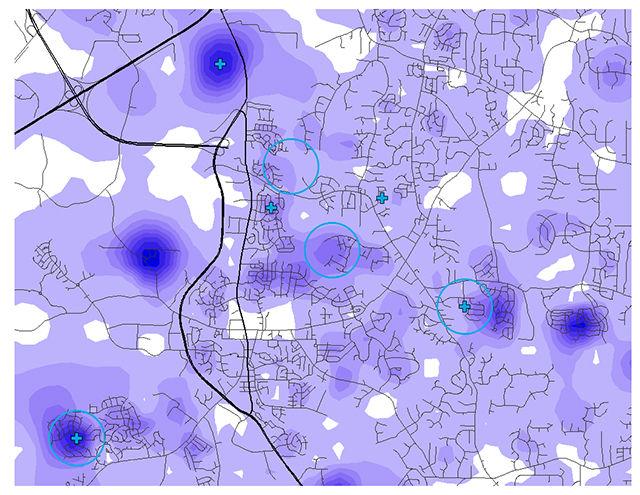Members of each school district boards constantly find themselves making the final call on everything from complex decisions involving future school planning and day-to-day operations.
In making these decisions schools and boards enlist the outside help of NC State’s Operations Research and Education Laboratory, or OREd Lab, provide data-driven solutions.
NC State Professor Raymond G. Taylor founded OREd in 1990. It was later incorporated into the Institute for Transportation Research and Education, or ITRE, which was established in 1976 and officially incorporated at NC State in 1978.
The process by which OREd carries out its numerous services is Integrated Planning for School and Community (IPSAC), and through IPSAC, the OREd Lab analyzes enrollment projections, school district growth potential and school siting.
Michael Miller, the OREd lab program manager, said every school district the lab works with is distinct, each having a different amount of students as well as challenges.
“We work with districts ranging in size from 5,000 to students to a district the size of Wake County,” Miller said. “We’ve been working with Wake County for more than a decade, and there’s 160,000 students there.”
According to Miller, OREd uses different approaches to address each district’s own unique set of challenges, but there are some tools that are central to their analysis across districts.
“One of the biggest [approaches] is using GIS data,” Miller said. “GIS stands for geographic information systems, and this is a newer development for OREd. The software has only been available in a form that we can use for 15 to 20 years, so in the last decade we’ve really tried to push GIS analysis and use it to its fullest extent to help districts.”
GIS data is a common tool used in OREd’s districts. By using GIS data, along with data input directly from planning agencies within the district, OREd tries to determine how many students will be in that district over the next decade and where they are going to be located.
Another aspect of the lab is its operations research. It is used to enable administrators to make decisions wisely, to articulate planning needs to the public and stakeholders, to thoroughly evaluate policy alternatives, and to gain public confidence on the decisions, according to the OREd Lab site.
“It still doesn’t make the decisions any easier,” Miller said. “I mean board members are challenged with very sensitive decisions about where new schools are going to be and which families are going to go to that school, and those are tough decisions. What we [OREd] try to do is give them — using the best data that we have, the best methods that we have — we try to allow them to make these decisions based on data and based on our tools.”
OREd currently works with roughly 15 to 20 districts across various levels of complexity, and districts typically learn about OREd through word of mouth.
“Most of the boards that we work with are very open to this process — they love data, they ask great questions to OREd and that’s kind of the mark of a successful project,” Miller said. “If you get a board that’s involved and wants to know how this process works, that’s kind of a hallmark of success.”
Although OREd has been involved with the Wake County school board for about a decade, it extends its services to districts outside of Raleigh and outside of North Carolina as well, according to Thomas Dudley, a research associate with OREd.
“We also work with a lot of the counties that are around sort of outside of Raleigh — Harnett and Johnson and Chatham — those are some of the major ones outside of Raleigh,” Dudley said. “Outside of North Carolina we do work with several [school districts]. The major ones have been Rock Hill, South Carolina; Stafford, Virginia, and we started working with Lawrence, South Carolina.”
Miller explained there are different challenges that these regions and districts face, but in general, they do share some common problems related to school planning.
“A lot of [these regions] have the same problems: where to find money to build schools, how to accommodate growth, but the way that they work is often very different from state to state and from district to district,” Miller said.
More specifically, Miller said the biggest challenge OREd faces with each of the districts, no matter their locations, is to not only “make sense” of the numbers of the districts, but to “make sense” of the political environment as well.
“One of the challenges is to try to understand how different districts, with their own set of challenges, approach these problems,” Miller said. “And it’s our job to try to get the solution that not only makes the numbers make sense, but also makes sense in the political environment of that particular district. That’s a challenge; that’s hard. That’s not something that the numbers tell you all the time.”
During OREd’s work, the lab often teams with ITRE and has worked with people in transportation as well. According to Miller, he has also worked with North Carolina Department of Transportation’s Division of Aviation, and the operations research part of OREd can extend beyond school districting.
“The major thing for OREd is trying to help more districts and getting into the political climate and try to be that voice of the logic side and the math, you know, what do the numbers really recommend,” Dudley said. “We’re working with more clients, bigger clients and just really trying to help make schools be built in places where they really need it and help the kind of plans that are there, and logical and based on what’s best for the students.”








